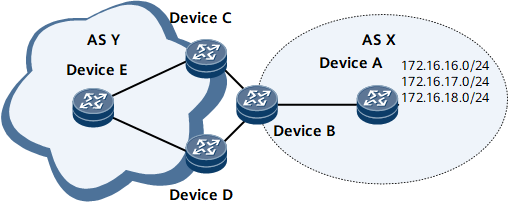Application Scenarios for XPL
Using XPL to Filter Routes
On the network shown in Figure 1, Device A has routes to 172.16.16.0/24, 172.16.17.0/24, and 172.16.18.0/24. The networking requirements are as follows:
Device A advertises only route 172.16.17.0/24 to Device B.
After receiving the route from Device B, Device C forwards it directly to Device E, and Device D increases the MED attribute of the route before forwarding it to Device E to ensure that Device C functions as the egress for the traffic from Device E to 172.16.17.0/24.
The preceding requirements can be met using an IPv4 prefix
set:
- Configure an IPv4 prefix set named ip-prefix1, which includes only the 172.16.17.0 24 element, on Device A.
- Configure a route-filter named route-filter1 on Device A, which permits the route carrying the element in ip-prefix1 and denies other routes.
- Configure route-filter1 as an export policy on Device A so that Device A advertises only route 172.16.17.0/24 to Device B.
- Configure an IPv4 prefix set named ip-prefix2, which includes only 172.16.17.0 24, on Device D.
- Configure a route-filter named route-filter2, which increases the MED value of the route carrying the element in ip-prefix2, on Device D.
- Configure route-filter2 as an export policy on Device D so that the MED value of the route advertised by Device D is greater than that of the route advertised by Device C, making Device C the egress for the traffic from Device E to 172.16.17.0/24.
